Are your projects held back by subpar floodlights? Poor quality lights lead to frequent failures and high energy costs, damaging your reputation and budget. You need a reliable way to choose superior products.
The key features to look for in an LED floodlight are high lumen efficiency (lm/W), a durable housing with strong IP and IK ratings, and effective thermal management. Critically, you should also examine the advanced optical design, like a combined lens and reflector system for precise light control.
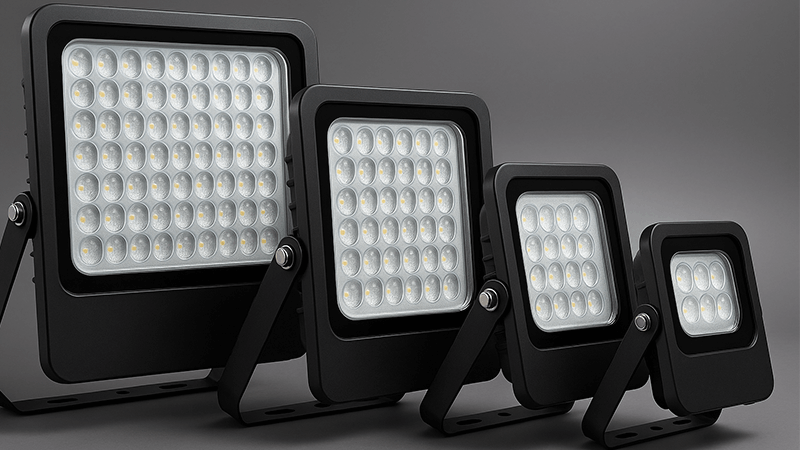
As a purchasing manager, your choices directly impact a project’s success and your company’s bottom line. I’ve spent my entire career in LED lighting, from the factory floor to running my own manufacturing business, so I understand what separates a great floodlight from a liability. It goes far beyond the price tag. Let’s break down the essential features you need to check to ensure you’re sourcing lighting quality you can see, every single time.
How to choose LED floodlights?
Picking the wrong floodlight wastes money and delivers poor results. It can make a brand-new project look unprofessional from day one. You need a simple method to get it right.
To choose the right LED floodlight, first define your application’s specific needs. Then, check essential specifications like lumens, CCT, and durability ratings. Always verify certifications and, most importantly, assess the manufacturer’s quality control and technical support.
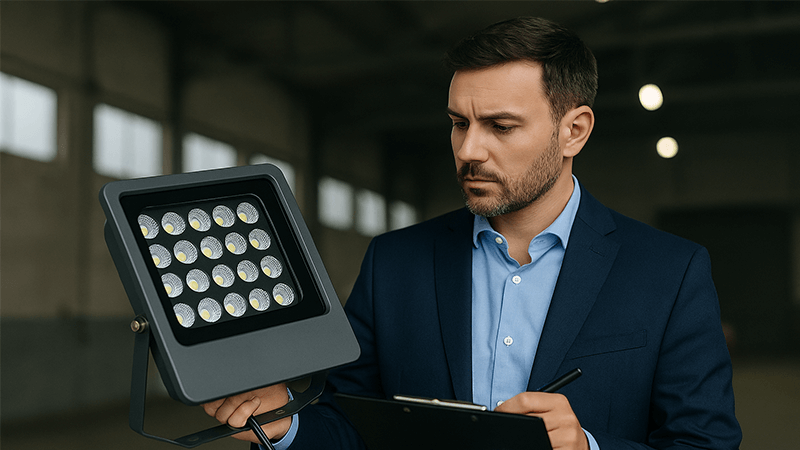
A Deeper Look into the Selection Process
Choosing the right floodlight is a systematic process, not a guess. In my years of helping clients like you, I’ve found that breaking it down into a few key steps eliminates almost all purchasing errors. It ensures the product you buy is the product you actually need for the job.
1. Define the Application First
Before you even look at a specification sheet, you must know what you are lighting.
- What is the target? Is it a wide parking lot, a tall building facade, a security zone, or a small garden?
- What is the goal? Is it for general safety, architectural aesthetics, or task-specific work?
The answer to these questions determines everything else. For a wide area, you need a wide beam angle. For a tall structure, you need a narrow, focused beam to push light upwards. I remember a client who bought powerful wide-beam floodlights for a 10-story building. The light was bright at the bottom but faded into nothing by the third floor. A simple switch to a narrow-beam optic solved the problem completely.
2. Analyze the Key Specifications
Once you know your goal, you can look at the numbers. Don’t get fixated on just one.
| Specification |
What It Means |
Why It Matters for You |
| Lumen Output (lm) |
The total amount of visible light emitted. |
This is the true measure of brightness, not wattage. Higher lumens mean more light. |
| Lumen Efficacy (lm/W) |
How efficiently the light converts power into light. |
A higher number means more light for less energy. This is a direct indicator of quality and impacts long-term operational costs. |
| Correlated Color Temp (CCT) |
The color of the light, measured in Kelvin (K). |
3000K is warm white (like a home), 4000K is neutral, and 5000K+ is cool white (like daylight). The choice affects the mood and visibility of the space. |
| IP & IK Ratings |
Protection against solids/water (IP) and impacts (IK). |
IP65 is a minimum for outdoor use. Higher ratings like IP66/67 mean better durability against harsh weather. An IK08 rating ensures it can handle physical impacts. |
3. Verify Certifications and Supplier Reliability
Certifications like CE, RoHS, UL, or ENEC are not just logos. They are proof that the product has been tested and meets critical safety and performance standards for your region. More than that, look at the supplier. Do they offer a comprehensive warranty? Can they provide technical support and lighting simulation files (DIALux)? A good partner stands behind their product.
Are 100 watt LED floodlights better than halogen?
Still considering old halogen technology? The high energy bills, constant bulb replacements, and intense heat create endless maintenance problems and drive up operational costs for your clients.
Absolutely. A 100W LED floodlight is significantly better than a comparable 500W-750W halogen. The LED uses around 80% less energy, lasts up to 25 times longer, runs much cooler, and is far more durable, making it the superior choice for any professional application.
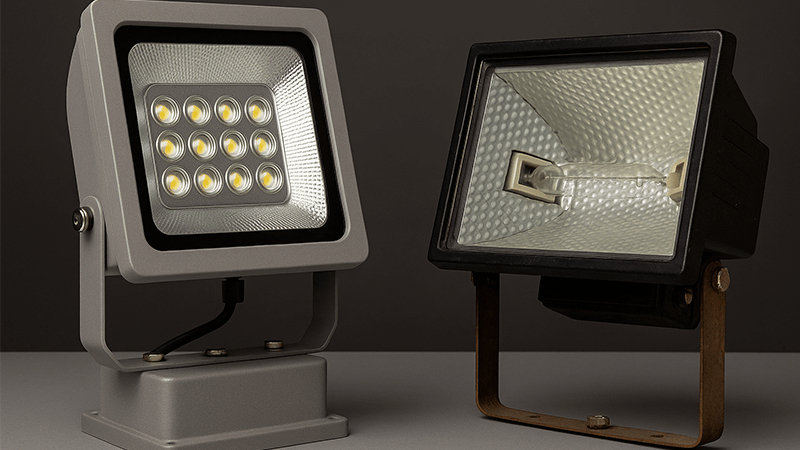
Crunching the Numbers: LED vs. Halogen
When I started in this industry, halogen was the standard. But the day we produced our first high-power LED floodlight, I knew the game had changed forever. The difference in performance isn’t just small; it’s a total transformation. Let’s look at the data side-by-side. Imagine you need to light a commercial space and are deciding between a 100W LED and a 500W Halogen that produces similar brightness.
| Feature |
100W LED Floodlight |
500W Halogen Floodlight |
The Professional’s Takeaway |
| Power Consumption |
100 Watts |
500 Watts |
The LED provides the same or more light for 80% less energy. This is a massive, immediate saving on electricity bills. |
| Average Lifespan |
50,000+ hours |
~2,000 hours |
The LED lasts 25 times longer. This nearly eliminates the cost and labor of frequent replacements. For hard-to-reach installations, this is a huge benefit. |
| Heat Output |
Low |
Very High |
Halogen floods get dangerously hot, posing a fire risk and damaging nearby surfaces. LEDs run cool, making them safer and more versatile. |
| Durability |
Very High (Solid-State) |
Low (Fragile Filament) |
LEDs are resistant to shock and vibration. Halogen bulbs have a delicate filament that can break easily, leading to premature failure. |
The initial purchase price of an LED fixture might be higher. But a professional purchasing manager like you knows that the real number to watch is the Total Cost of Ownership (TCO). When you factor in energy savings and the near-zero maintenance over its long life, the LED floodlight is overwhelmingly the cheaper and better option. I once had a client who was hesitant to make the switch for a large warehouse project. We ran the TCO calculation, and it showed they would break even in just 11 months and save tens of thousands of dollars over the next five years. They placed the order immediately.
What is the best wattage for flood lights?
Feeling unsure about which wattage to select? Choosing one that’s too low results in dark, unsafe spots. Choosing one that’s too high creates glare and wastes enormous amounts of energy.
There is no single "best" wattage; it is entirely dependent on the application. The right wattage is determined by the required brightness (lumens) and the size of the area you need to illuminate. Wattage tells you power consumption, not brightness.
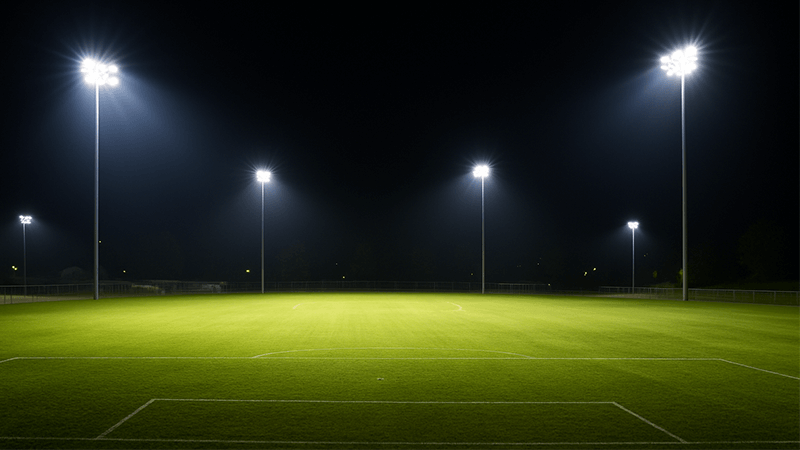
Moving from Wattage to Application
In the old days of lighting, we used wattage as a shortcut for brightness. A 100W incandescent bulb was always about the same brightness. With LEDs, that thinking is obsolete. A high-quality 100W LED can be brighter than a low-quality 150W LED. That’s why professionals focus on lumens and lux levels on the target surface.
However, wattage can still be a useful starting point to narrow down your options based on the scale of your project. Here is a general guide I use when consulting with clients.
Common Applications and Wattage Ranges
| Application Type |
Common LED Wattage Range |
Key Considerations for a Professional |
| Residential Accent & Security |
10W – 30W |
Used for lighting up doorways, gardens, or pathways. The goal is visibility and aesthetics, not high-intensity illumination. |
| Building Facades & Signage |
50W – 150W |
Here, the beam angle is critical. You need enough power to light the structure evenly without creating hot spots or wasting light into the sky. |
| Commercial Parking Lots |
100W – 300W |
The main goals are safety and uniformity. You need to eliminate dark spots between poles and ensure good visibility for both drivers and pedestrians. |
| Large Areas (Sports Fields, Ports) |
400W – 1200W+ |
These are high-power applications requiring specialized optics, excellent glare control, and maximum lumen output to meet strict lighting standards. |
My advice is to use wattage for initial budgeting and product filtering. But for the final decision, you must demand more data from your supplier. Ask for a photometric file (an .ies file) and, if possible, run a simulation in a program like DIALux. This will show you exactly how a specific floodlight will perform in your specific environment. A serious manufacturer will gladly provide this because it proves their product’s performance. Thinking in lumens and lux, not just watts, is the mark of a true lighting professional.
How to choose the right size outdoor lighting?
Does choosing between different physical sizes of fixtures feel confusing? A fixture that is too large can ruin a building’s architecture, while one that’s too small looks weak and provides poor light.
"Size" has two meanings: physical scale and optical performance. Match the fixture’s physical dimensions to the structure for good aesthetics. For performance, focus on the optical design, as a smaller, well-engineered light can easily outperform a larger, inefficient one.
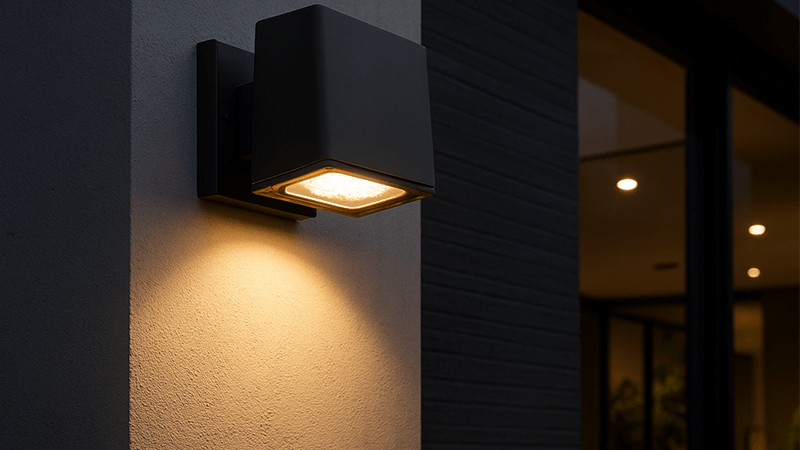
Understanding Physical vs. Optical Size
When we talk about "size," we are really talking about two different things. Both are critical for a successful project. Making a mistake on either one can lead to disappointment for your client. I’ve seen this happen many times. Let’s make sure it doesn’t happen to you.
1. Physical Size and Architectural Scale
The physical fixture itself is an architectural element. It has to look right. A giant floodlight mounted next to a small residential door looks awkward and out of place. A tiny fixture at the top of a 20-meter pole looks lost and ineffective.
A good rule of thumb for wall-mounted lights is to choose a fixture that is roughly 1/4 to 1/3 the height of the element it is lighting, like a door or a large window. For pole-mounted lights, the scale should match the height of the pole and the scope of the area. Aesthetics matter, and a well-scaled fixture shows a high level of professionalism.
2. Optical Size and Performance-Driven Design
This is where my experience on the factory floor becomes most valuable. The true power of a floodlight isn’t determined by its physical size, but by the quality of its internal components. A larger fixture often just means an older, less efficient design with a bigger heat sink. A modern, compact fixture can deliver more usable light.
The secret lies in the optical system. The most effective floodlights use a combination of a lens and a reflector.
- The Lens: This primary optic sits directly over the LEDs. Its job is to collect the raw light and shape it into a specific beam angle (e.g., narrow 30° or wide 90°).
- The Reflector: This secondary optic surrounds the lens. Its purpose is to capture any stray light that escapes the lens and redirect it forward into the main beam.
This lens + reflector combination ensures maximum beam utilization. Almost no light is wasted inside the fixture. To take this a step further, the highest-performing models apply a high-reflectivity coating to the surfaces of both the reflector and the lens. Think of it like a perfectly polished mirror versus a dull one. This coating minimizes internal light loss and boosts the final lumen output significantly. At my factory, we scrutinize this coating process because we know it can increase light efficiency by 5-10%. For a large project with hundreds of lights, that is a massive increase in performance and value for the same amount of energy. So, when you choose a fixture, don’t be fooled by a big, heavy body. Ask about the optical design inside. That is where real quality lies.
Conclusion
Choosing the right LED floodlight means you must look beyond just wattage. Focus on efficiency, durability, and especially the quality of the optical design. This ensures your projects shine brightly for years.